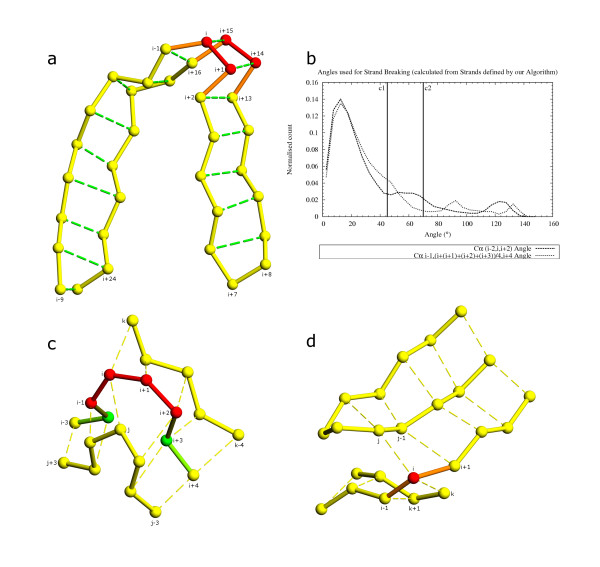Figure 9.
β-strands redefined to obtain linear elements using different methods. 9a: Strands broken based on i, i+3 Cα distance (fig. 4a). Distance between i-1, i+2 residues and i+13, i+16 residues fail the cutoff distance of 8.1 Å. The residues i, i+1 (shown in red) are shared by β-strands i-9, i+1 and i, 1+7. Residues i+15, i+14 (shown in red) are shared by the β-strands i+24, i+14 and i+15, i+8. 9b: Angles for β-strand breaking while accounting for bulges. Angles were calculated from all β-strands defined by our algorithm before the β-strand-breaking step. The angle between i-2, i, i+2 Cα atoms is used to determine if the β-strand is bent. An average pseudo-point (pp) was generated from the j, j+1, j+2, j+3 atoms and the angle between j-1, pp, j+4 was found. β-strands were broken when i-2, i, i+2 angle was greater than c1 (45°) and j-1, pp, j+4 angle was greater than c2 (70°). j = i-1 showed the best correlation between the two angles (data not shown). 9c: Strand breaking using pseudo-point to find distorted regions. Residues i-1, i, i+1, i+2 (shown in red) are used to generate an average point. Angle between i-2, the average point and i+3 locates a distorted region if the cutoff angle of 70° fails. The β-strand is broken if the i-2, i, i+2 angle also fails at the same location. The β-strand i-3, i+4 is split to generate two β-strands i-3, i+1 and i, i+4. 9d: Strand breaking using pairing information between neighboring β-strands. Residue i (shown in red) is paired to residue j on one side and to residue k on the other. Residue i+1 is paired to residue j-1 however residue i-1 is not paired to β-strand j. Also, residue i-1 is paired to residue k+1 but residue i+1 is not paired to β-strand k. Lack of a pair of common residues pairing between β-strand j and k splits the sheet, with residue i shared between both sheets.

